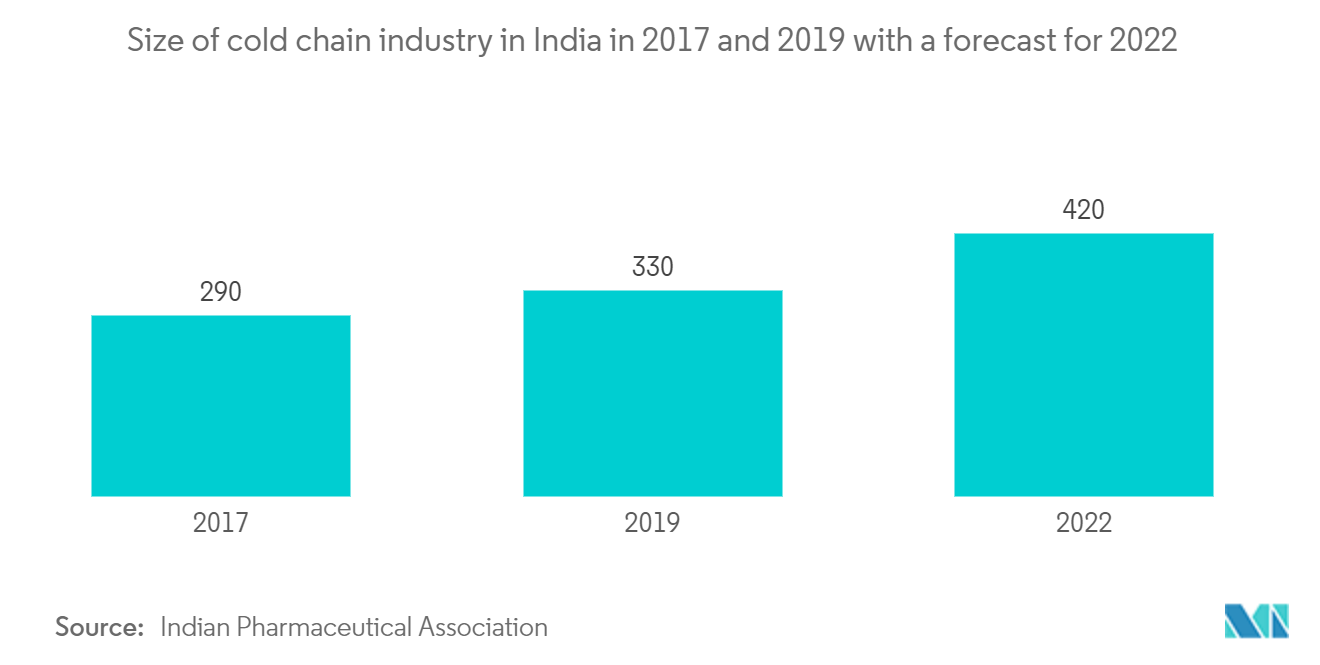Market Trends of Smart Food Logistics Industry
This section covers the major market trends shaping the Smart Food Logistics Market according to our research experts:
Cold Chain Monitoring to Hold a Significant Share
A cold chain monitoring solution helps food manufacturers manage temperature-controlled items' storage, shipment, and distribution. Incomplete cooling chains caused by mechanical breakdowns, traffic delays, and other reasons result in shifting temperatures, which can influence the spoilage and safety of perishable foods. In addition, a lack of real-time visibility of goods' locations might contribute to an inefficient operating process.
- As a result, the adoption of cold chain monitoring ensures stable temperatures for transporting and storing goods. Technologies like Bluetooth Low Energy (BLE) beacons with temperature sensors enable tracking goods' locations at relevant checkpoints and tracing temperature data continuously and seamlessly during shipment or throughout the supply chain. However, the need to maintain the cold chain throughout the delivery process raised a significant barrier for many producers of perishable goods, artisanal food producers, and farmers with little or no logistical capacities of their own.
- Moreover, rapidly changing food habits have boosted demand for packaged food, and stringent packing and storage regulations have resulted in a power transfer from manufacturers to merchants. The primary reasons propelling automation and technology adoption in food and beverage logistics include processes focusing on zero contamination, precise storage, and high-speed storage and retrieval operations.
- Companies such as Walmart have made considerable investments in automated grocery selection robots. Alphabot picks orders within the warehouse, utilizing autonomous carts to pick frozen and refrigerated groceries stored at ambient temperature. The robot identifies an item, picks it up, and carries it to a workstation for inspection by a staff person. Such industry automation advancements are projected to generate considerable prospects for cold chain monitoring solution adoption.
- As per the Indian Pharmaceutical Association, in 2019, the total size of the cold chain industry in India was around 330 billion rupees (USD 3987307500), and it was estimated to reach 420 billion rupees (USD 5076288000) in 2022. In 2020, it was predicted that India would have approximately 37.4 million metric tons of cold chain storage capacity. Due to the rise in the cold chain industry, the market is expected to witness significant growth opportunities throughout the forecast period.

North America Holds Major Share
Because of the presence of many vendors and the growing concern to eliminate waste and optimize resources, the North American region is expected to have the largest share of smart logistics adoption.Moreover, North America is a significant asset tracking market due to the region's strong presence in the manufacturing, transportation, and logistics industries and various technological advancements. Furthermore, government initiatives and policies in different end-user sectors will likely boost regional market expansion.
- The government's drive to adopt technology to reduce waste in the supply chain is fueling the region's market growth. For example, the American Association of State Highway and Transportation Officials, the Federal Highway Association, and local departments of transportation have all supported the adoption of asset tracking in the transportation and logistics industry.
- Moreover, the market is witnessing various significant acquisitions, mergers, and investments by key players as part of their crucial growth strategy to improve business and their overall presence to reach customers and meet their requirements for various key applications. This is expected to open up a plethora of opportunities for the smart food logistics market to expand and improve over the forecast period.
- For instance, in February 2022, U.S. Department of Agriculture (USDA) Secretary Tom Vilsack declared that USDA is making available up to a sum of around USD 215 million in grants and other support to extend poultry and meat processing options, strengthen the overall food supply chain, and create jobs and economic opportunities, especially in rural areas. So, the USDA is very focused on taking steps to increase processing capacity and boost competition in the poultry and meat processing industries. This will make agricultural markets in the United States more competitive, fair, accessible, and stable for ranchers and farmers.
- Furthermore, U.S. Department of Agriculture (USDA) Secretary Tom Vilsack announced in October 2022 that the Department is investing approximately USD 11.1 million, primarily through the Food Supply Chain Guaranteed Loan Program, to assist Crystal Freeze Dry LLC in expanding its capacity to manufacture freeze-dried egg products and creating job opportunities in rural Iowa. The funding is a crucial part of the Biden-Harris Administration's commitment to strengthening the critical food supply chain infrastructure to build more thriving communities for the American people.


